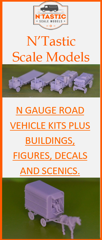- Welcome to N Gauge Forum.
Stationary winding Engine raising and lowering wagons up and down an inclineStarted by N Quay Harbour, September 01, 2024, 06:17:15 PM Previous topic - Next topic0 Members and 1 Guest are viewing this topic.
User actions
| Please Support Us!
April Goal:
£100.00 Due Date: Apr 30 Total Receipts: £0.00 Below Goal: £100.00 Site Currency: GBP 0% |







